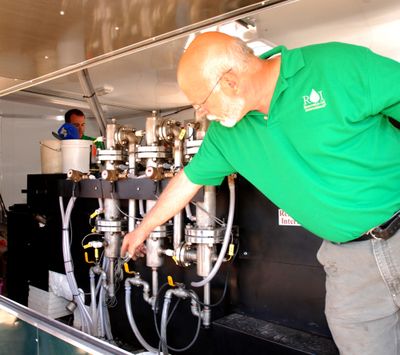Wood-to-oil process studied
Portable unit gets Forest Service notice

MERLIN, Ore. – For the past decade that the U.S. Forest Service has been pressing to thin hundreds of millions of acres of woods in danger of burning up, it has had one nagging problem: how to come up with the billions of dollars to pay for it.
Young trees are too small for lumber. Transporting the bulky material to biomass power plants is too expensive. And cutting big trees to pay for thinning the small ones often runs afoul of environmental laws.
Jim Archuleta, a soil scientist on the Umpqua National Forest in southwestern Oregon, thinks he might have the answer in a new twist on old technology called fast pyrolysis.
The demonstration unit he secured from Renewable Oil International in Florence, Ala., shoots superheated steel BBs into a chamber filled with wood chips to flash-bake them without oxygen. In a matter of seconds the wood turns into a bio-oil that can be upgraded to diesel, a mix of gases that can be tapped to fuel the pyrolysis process, and charcoal powder that helps trees and plants grow while providing long-term storage of carbon that would otherwise contribute to global warming.
“Until you can get it to pencil out, there is nobody willing to pony up that kind of money,” Archuleta said of the billions of dollars required to thin forests that a century of putting out wildfires has left in an unhealthy and flammable state. “This may offer enough value to actually generate enough money to make things viable.”
No one has penciled Archuleta’s solution out yet, and it is just starting to work its way up the Forest Service chain of command. But the technology has drawn the interest of the U.S. departments of Agriculture and Energy, universities and oil companies.
“There are a lot of exciting things happening,” said Sam Jones, associate director for research at the Center for Sustainable Environmental Technologies at Iowa State University. “The thing we are really working on now is how we get the bio-oil we make into a usable transportation fuel or commodity chemicals or heating oil.”
While ethanol has gotten all the attention, fast pyrolysis offers one big advantage for forests – it works on a small scale that makes it portable. The demonstration unit is on a trailer hauled by a pickup truck. A unit big enough to process 50 dry tons a day could be mounted on a semitruck, said Renewable Oil International President Phillip Badger.
“That is one of the leading technologies to potentially have a mobile system you could take into the woods to do this with,” said Rick Gustafson, professor of bioresource science and engineering at the University of Washington and co-author of the report “Wood to Energy in Washington: Imperatives, Opportunities and Obstacles to Progress.”
Not all the bugs were worked out of the demonstration unit hauled to the Josephine County waste transfer station for a demonstration this past week. A sensor had malfunctioned, probably from bouncing over bumpy roads. Badger said they had not had time to shake it down, due to the rush to meet the Forest Service schedule.
But there is no shortage of material to test, and most of what is available is going begging. A 2002 Forest Service report estimated 652 million acres of federal, state and private wildlands have a dangerous buildup of fuels. The Forest Service’s share is 131 million acres, an area bigger than Texas.
The U.S. Department of Agriculture, which oversees the Forest Service, is looking at fast pyrolysis of farm waste – though with a different process – as a way to help meet the 2007 Energy Independence and Security Act goal of 36 billion gallons of renewable fuels by 2022.
The ability of fast pyrolysis to function efficiently on a small scale makes it particularly attractive for putting mobile or permanent units on farms, said Akwasi Boateng, lead scientist on the Agricultural Research Service pyrolysis program in Wynmoor, Pa.
There is research being done to refine it and develop additives so it can be mixed directly with diesel to supplement transportation fuels, Boateng said.